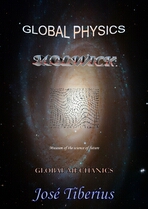4.b) Neutrinos as longitudinal waves
Given the physical model provided by Global Physics, we can make speculative proposals on one of the least understood particles in Modern Physics, due to its low interaction with normal matter.
As always, these proposals are renormalizable and deal with the following characteristics.
-
Neutrino mass
The mass of neutrinos affects the proposal in Global Mechanics regarding the electron as a physical limit for the creation of mass. In other words, elementary particles with a lower mass than the electron should not exist.
The elementary particles with mass in the Standard Model have a higher mass than the electron, but there are a few exceptions; two out of three neutrinos have a mass lower than that of the electron. In particular, the mass of the electron neutrino is approximately a million times smaller.
It is possible that what Quantum Mechanics considers the mass of neutrinos is not mass as defined in Global Mechanics, or perhaps it is a particular type of mass.
In fact, even the electron mass is not a consequence of the retention forces of Global Aether cells –Asymptotic freedom in QCD– as is the case for protons and neutrons; its origin lies instead in the energy barrier or the minimum energy necessary to prevent free electrons from breaking up –decaying– into photons.
The mass of the electron neutrino is so small that it could be massless –however, due to oscillations physicists say it has a non-zero mass. We will have to wait for the results of multiple current experiments and those scheduled for the near future.
-
Neutrinos could be longitudinal waves
The nature of neutrinos could lie in longitudinal waves through the filaments of Global Aether, instead of transverse waves such as in the case of photons. The origin of these waves would then be cracks or hard bends in the filaments produced during the creation of electrons and other particles with mass –weak interaction–, or the reversion of those cracks when particles decay into photons or smaller particles.
Simple physics experiment
Compressed air rifle
load and reload Longitudinal waves origin
When we load a compressed air rifle with its ammunition and snap it shut, a vibration occurs throughout the rifle due to its mechanism –stability barrier– that keeps the rifle ready to fire.
Likewise, a similar vibration will occur when opening the rifle to reload it.
This longitudinal wave nature of neutrinos would explain why the mass –or energy– of the electron neutrino is so small in comparison with that of the electron. In any case, the values of the masses of neutrinos are not definitive.
Little interaction of neutrinos with normal matter
The configuration of neutrinos as longitudinal waves is consistent with the small interaction they have with normal matter. If neutrinos were longitudinal waves, it would make sense that they would not interact much with the loops of Global Aether caused by transverse waves of electromagnetic energy.
Also, it makes sense that when they do interact they do through the weak interaction because it implies the creation or destruction of cracks in the filaments of the Global Aether.
The spin of the neutrinos could be due to the creation of folds in the filaments of the Global Aether –and the longitudinal internal wave that originates– does not occur in one plane of the three-dimensional space. On the contrary, it implies a twist that relaxes the transverse tension of said filaments; as explained when talking about electrons in the structure of the atom or the mechanism of creation of protons and neutrons.
-
Neutrinos and gravitational interaction
Due to the speed of neutrinos –almost equal to the speed of light–, the force of gravity will also affect them twice as much as the mass, just as it does to electromagnetic and kinetic energy according to the Law of Global Gravity.
-
Neutrinos and expansion of the universe
A consequence of the proposed nature of neutrinos is that they could produce or contribute to the expansion of the universe through the nuclear fusion processes of the stars.
* * *
When Einsoder finished the book,
he called Mª José to tell her how pleased he was.
Then, she said the following:
–It is very good.
I especially like the part about
the experiment with the sheet,
but do not forget that
some limits must sometimes be self-imposed,
Even if there aren't any!–
